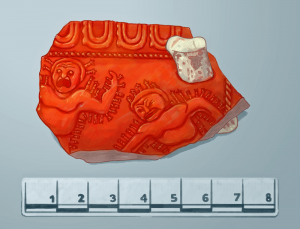An essay by Daniel Benlainey, as provided by Steve Toase
Art by Leigh Legler
Daniel Benlainey BA MSc
Project Manager
Multivallate Archaeology
Unit 4 Sunray Farm
YK94 1SX
D.Benlainey@multivallate.org.uk
Simon Campbell BSc
Senior Archaeologist
Historic Environment Team
Callshire County Council
County Hall
Ostbarnton
YK56 4RF
Dear Simon,
Please find attached the interim site report for the Carrion Knoll Excavation. Hope everything is OK. We’re still waiting on some results from a subcontractor, but I’ll forward them as soon as they arrive.
Yours sincerely
Daniel Benlainey BA MSc
~
Interim site report of Carrion Knoll Archaeological Excavations 2017 September 8th
Due to the position of the Carrion Knoll housing development in an area of known prehistoric and Roman activity, a planning condition for archaeological evaluation was required ahead of any groundworks.
Between August 1st and August 25th, a five-person team carried out the necessary work. Due to the low-lying nature of the site and anaerobic conditions found in certain areas, the quality of organic preservation was good, with several surprising results.
Three trenches, each 20m by 10m were excavated. These were distributed across the development area to give as wide a spread of results as possible.
Historic Background
Carrion Knoll lies in an area of known Neolithic, Iron Age, Roman, and Anglo-Scandinavian activity, though no known archaeological material has previously been recovered from the exact site location. Since approximately 900AD, there is no evidence of activity in the vicinity.

In nearly thirty years as a professional Romano-British ceramic specialist, I have never encountered bone and pottery fused together in such a way.
To read the rest of this story, check out the Mad Scientist Journal: Spring 2019 collection.
Daniel Benlainey was born in Fife, Scotland, and got his BA in Archaeology from the University of Sheffield, before completing an MSc in Archaeological Sciences at the University of Bradford. After working the commercial archaeology ‘circuit’ for several years, Daniel has been with Multivallate Archaeology for a decade, starting as a site assistant and working his way up to a project management position. He is especially interested in vitrified forts. When not working he spends his time seeing bands such as Blyth Power, New Model Army, and Flogging Molly, or playing for his local cricket team.
Steve Toase lives in Munich, Germany. His work has appeared in Shimmer, Lackington’s, Aurealis, Not One Of Us, Hinnom Magazine, Cabinet des Feés, and Pantheon Magazine, amongst others. In 2014, “Call Out” (first published in Innsmouth Magazine) was reprinted in The Best Horror Of The Year 6. He first worked on an archaeological site in 1994, and has an MA in Landscape Archaeology. He spent too many years digging big holes looking for old stuff, and once found 1,000 year old human hair. He also likes old motorbikes and vintage cocktails. You can keep up to date with his work via http://www.tinyletter.com/stevetoase, facebook.com/stevetoase1, www.stevetoase.wordpress.com, and @stevetoase.
Leigh’s professional title is “illustrator,” but that’s just a nice word for “monster-maker,” in this case. More information about them can be found at http://leighlegler.carbonmade.com/.
“Terminus Post Quem” is © 2019 Steve Toase
Art accompanying story is © 2019 Leigh Legler
 If you’re a Shakespeare fan, you might be interested in My Kingdom for a Panel, a Shakespearean graphic novel anthology. Featuring 26 re-imagined and illustrated Shakespearean tales, this graphic novel anthology looks absolutely awesome. They’ve also got a couple of cute add-ons and opportunities to get original artwork from some of the illustrators as well. We’re particular enamored of the Happy Dagger pin and the Shakespeare sticker waving the Pride flag.
If you’re a Shakespeare fan, you might be interested in My Kingdom for a Panel, a Shakespearean graphic novel anthology. Featuring 26 re-imagined and illustrated Shakespearean tales, this graphic novel anthology looks absolutely awesome. They’ve also got a couple of cute add-ons and opportunities to get original artwork from some of the illustrators as well. We’re particular enamored of the Happy Dagger pin and the Shakespeare sticker waving the Pride flag.
 Gunsmoke and Dragonfire
Gunsmoke and Dragonfire



 Many people, both those who own cats and those who do not, have a belief that cats are anti-social or aloof. Scientists have found, however, that cats are only as aloof toward you as you are toward them.
Many people, both those who own cats and those who do not, have a belief that cats are anti-social or aloof. Scientists have found, however, that cats are only as aloof toward you as you are toward them.